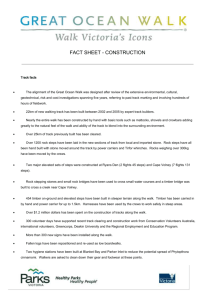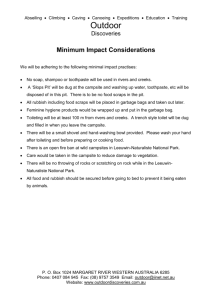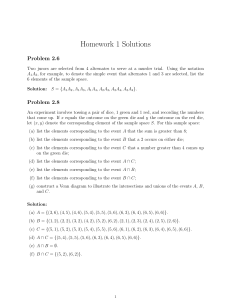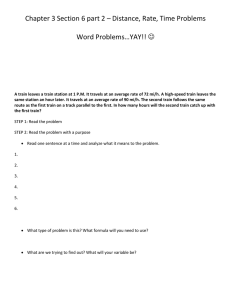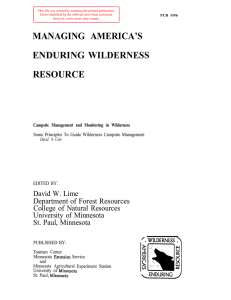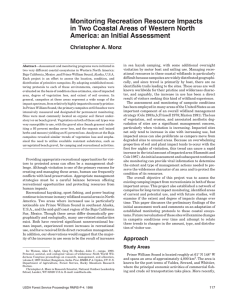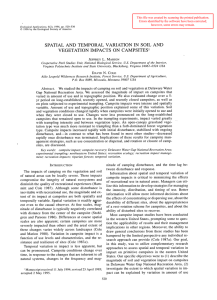This document is contained within the Recreation Site Monitoring Toolbox... . Since other related resources found in this toolbox may... Wilderness.net
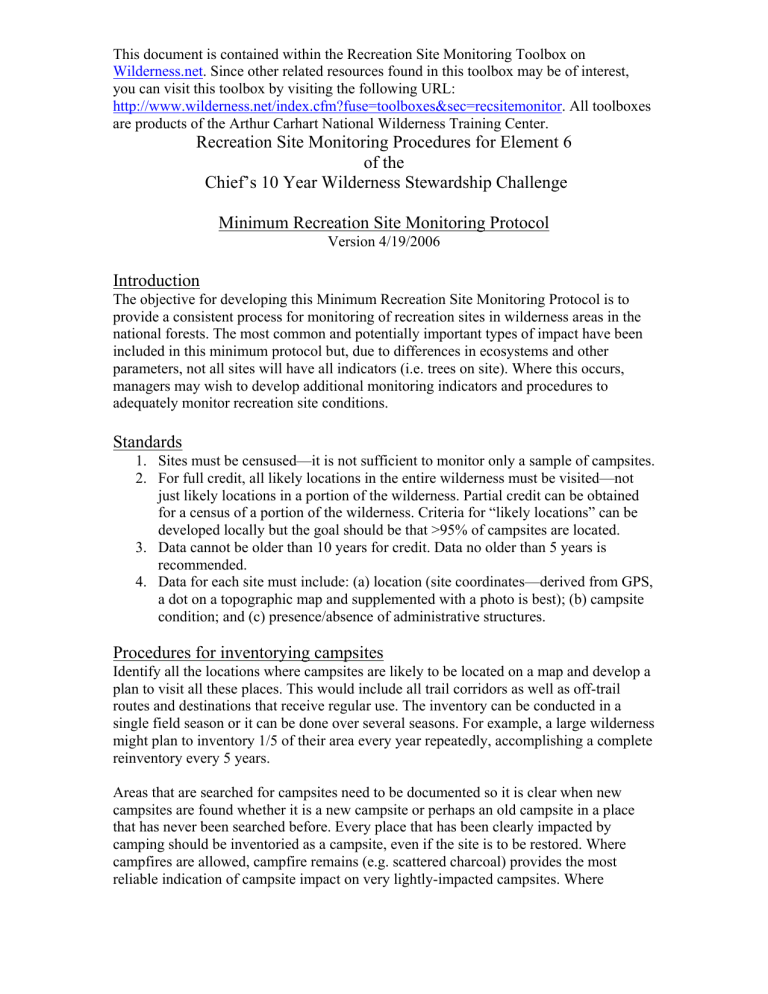
This document is contained within the Recreation Site Monitoring Toolbox on
Wilderness.net
. Since other related resources found in this toolbox may be of interest, you can visit this toolbox by visiting the following URL: http://www.wilderness.net/index.cfm?fuse=toolboxes&sec=recsitemonitor . All toolboxes are products of the Arthur Carhart National Wilderness Training Center.
Recreation Site Monitoring Procedures for Element 6 of the
Chief’s 10 Year Wilderness Stewardship Challenge
Minimum Recreation Site Monitoring Protocol
Version 4/19/2006
Introduction
The objective for developing this Minimum Recreation Site Monitoring Protocol is to provide a consistent process for monitoring of recreation sites in wilderness areas in the national forests. The most common and potentially important types of impact have been included in this minimum protocol but, due to differences in ecosystems and other parameters, not all sites will have all indicators (i.e. trees on site). Where this occurs, managers may wish to develop additional monitoring indicators and procedures to adequately monitor recreation site conditions.
Standards
1.
Sites must be censused—it is not sufficient to monitor only a sample of campsites.
2.
For full credit, all likely locations in the entire wilderness must be visited—not just likely locations in a portion of the wilderness. Partial credit can be obtained for a census of a portion of the wilderness. Criteria for “likely locations” can be developed locally but the goal should be that >95% of campsites are located.
3.
Data cannot be older than 10 years for credit. Data no older than 5 years is recommended.
4.
Data for each site must include: (a) location (site coordinates—derived from GPS, a dot on a topographic map and supplemented with a photo is best); (b) campsite condition; and (c) presence/absence of administrative structures.
Procedures for inventorying campsites
Identify all the locations where campsites are likely to be located on a map and develop a plan to visit all these places. This would include all trail corridors as well as off-trail routes and destinations that receive regular use. The inventory can be conducted in a single field season or it can be done over several seasons. For example, a large wilderness might plan to inventory 1/5 of their area every year repeatedly, accomplishing a complete reinventory every 5 years.
Areas that are searched for campsites need to be documented so it is clear when new campsites are found whether it is a new campsite or perhaps an old campsite in a place that has never been searched before. Every place that has been clearly impacted by camping should be inventoried as a campsite, even if the site is to be restored. Where campfires are allowed, campfire remains (e.g. scattered charcoal) provides the most reliable indication of campsite impact on very lightly-impacted campsites. Where
campfires are not allowed, other criteria will have to be developed for identifying lightlyimpacted campsites. At each inventoried campsite, either use a GPS to obtain site coordinates or carefully place a dot on a topographic map and obtain site coordinates from the map. Particularly if a GPS is not used, take a photograph of the campsite to facilitate future relocation of the campsite.
Procedures for assessing campsite condition
Independently assess (1) groundcover disturbance of the main campsite, (2) impact to standing trees and roots, and (3) size of disturbed area (including satellite tent pads and stock-holding areas). Each of these three parameters should be separately assessed. They are combined in a single impact index but the individual ratings will be kept separate as well. In addition, any administratively provided structures are recorded.
Record disturbance to the groundcover of the central portion of the campsite
(disregarding satellite disturbed areas) as one of the following classes. Select a midpoint when the condition is close to the boundary between classes
.
1 – Ground vegetation flattened but not permanently injured. Minimal physical change except for possibly a simple rock fireplace.
2 – Ground vegetation worn away around fireplace or center of activity.
3 – Ground vegetation lost on most of the site, but humus and litter still present in all but a few areas.
4 – Bare mineral soil widespread over most of the campsite.
As a general rule of thumb, if bare area (without vegetation) is virtually absent, assign a rating of 1. If bare area is obvious at the center of the site, extending out somewhat from a fire ring, but a single 2-person tent would extend onto portions of the site that are still vegetated (i.e. the bare area cannot accommodate both a fire ring and a single tent), assign the site a rating of 2. If the central bare area is large enough to accommodate a fire ring, as well as two 2-person tents, assign a rating of 3 (if most of the bare area still retains a humus/litter cover) or a rating of 4 (if the humus/litter cover is gone from most of the site). A site with enough bare area to accommodate a fire ring and one adjacent 2person tent would be given a rating of 2.5.
Record tree damage as one of the following classes, depending on the number of trees that have been severely damaged. Assess damage off-site as well as on-site, particularly in stock-holding areas associated with the campsite. Include any trees judged to have been damaged as a result of camping activities at the site being monitored. Severely damaged trees are those that (1) have been felled and are at least 10 cm (4 inches) in diameter where felled (if trees have multiple stems, consider the tree felled if any stem at least 10 cm (4 inches) in diameter has been cut off); (2) have scarring that exceeds 1000 cm
2 (
1 ft
2 ) in total area or (3) have highly exposed roots (more than 1 m (3 feet) of root sticks out at least 2.5 cm (1 inch) above the ground surface). Select a midpoint when the condition is close to the boundary between classes.
2
0 – No more than 3 severely damaged trees.
1 – 4 to 10 severely damaged trees.
2 – More than 10 severely damaged trees.
Record disturbed area as one of the following classes, depending on the size of the area disturbed by camping activities, including the main campsite, satellite tent pads and areas where horses are confined. Where there is a landing area for boats, include this. In most situations, disturbed places are distinguished by obvious vegetation loss (either complete lack of vegetation or sparse vegetation resulting from trampling). Places where vegetation has been flattened but is likely to recover in the short-term should not be included in the disturbed area. Where vegetation is naturally absent, it may be necessary to identify disturbed places on the basis of flattening of soil or litter on the forest floor (see special situation 1 below). When there are multiple separate disturbed parts of the campsite, do
NOT include undisturbed areas in between. For example, if there is a main campsite, two tent pads and a stock-holding area, assess the size of each of the four areas separately and then sum them. Social trails between separate disturbed areas can be ignored. Select a midpoint when the condition is close to the boundary between classes.
0 – No more than 25 m
2
1 – 26 to 100 m
2 (
(0-250 ft
251 - 1000 ft
2 – More than 100 m
2
2 ).
2 )
.
(more than 1000 ft
2 ).
Using this protocol, assign the campsite an overall impact rating between 1 and 8. This is the sum of the groundcover disturbance rating (1-4), the tree damage rating (0-2) and the disturbed area rating (0-2). It should take no more than a minute or two to assign a rating.
Record the presence/absence of various administrative structures . If structures are present, note their type (e.g. corral, table, toilet, fireplace, etc.) and the number of each.
This should not include user-built structures, although information about the prevalence of user-built structures is one of many types of recommended information that go beyond the minimum protocol.
Special Situations
1 . Procedures for campsites without much perennial understory vegetation and/or without organic soil horizons.
On sites without organic soil horizons and/or much perennial vegetation (for example, desert sites, beaches, sites on rock, sites dominated by annual vegetation or sites in the dense shade where understory vegetation is absent), the groundcover class definitions must be adapted. It would be good to note whether standard or adapted groundcover classes were used.
In ecosystem types with a poorly developed organic soil horizon, use the level of soil compaction to differentiate between class 3 and class 4 campsites. Where there is sparse but regularly-distributed perennial vegetation, use the size of the central area from which all perennial vegetation has been eliminated (irregardless of the annual vegetation) to differentiate between class 2 and class 3. Where there is little perennial vegetation, use
3
the size of the central area that has experienced long-term flattening of the soil surface to differentiate between class 2 and class 3. This might involve flattening of microbiotic crusts and a hummocky or rocky surface in deserts or flattening/abrasion of forest litter in dense shade. Conversely, a campsite entirely confined to a vegetation-less beach or a rocky ledge would always get a rating of 1 because there is no long-term flattening of the soil.
Ratings for sites in ecosystem types that have perennial vegetation but lack organic horizons would be as follows:
1 – Evidence of camping but minimal physical change except for possibly a simple rock fireplace.
2 – Perennial vegetation gone and soil surface flattened (for the long-term) around fireplace or center of activity.
3 – Perennial vegetation gone and soil surface flattened (for the long-term) on most of the site, but exposed mineral soil not highly compacted except in a few areas.
4 – Mineral soil exposed and highly compacted (to a cement-like state) over most of the campsite.
Ratings for sites in ecosystem types that lack both perennial vegetation and organic horizons would be as follows:
1 – Evidence of camping but minimal physical change except for possibly a simple rock fireplace.
2 – Soil surface flattened (for the long-term) around fireplace or center of activity.
3 – Soil surface flattened (for the long-term) on most of the site, but exposed mineral soil not highly compacted except in a few areas.
4 – Mineral soil exposed and highly compacted (to a cement-like state) over most of the campsite.
2. Procedures for campsites with no trees
These campsites would be given a rating of 0 (no tree damage).
Procedures for wildernesses with established campsite monitoring protocols
Some wildernesses already have impact assessment procedures that are as effective as our proposed procedures but that are simply different. These procedures are adequate for getting credit for Element 6 if they record
(a) location; (b) campsite condition; and (c) presence/absence of administrative structures and meet the other standards described above.
Recommended Additional Procedures
We strongly recommend that this minimum protocol be supplemented with additional data that is both more comprehensive and more precise. This minimum protocol does not provide information sufficient to be used to assess change over time on individual sites, unless the amount of change is huge. Nor does it document all the significant types of impact occurring on campsites. We are in the process of developing further information for monitoring protocols that go beyond the minimally acceptable procedures described above.
4



